23 April to 25 April 2021
The world continues to grapple with COVID outbreaks as internationally governments have placed hope in a vaccine that seems to be doing little to stem the flow of cases. As I type India is seeing over 350,000 cases a day and the world is at a tipping point on the verge of 1,000,000 new cases every day.
However here in Australia it seems apart from the odd pocket of cases and short term strict lock downs, one happening now in Perth, we are largely COVID free and able to travel.
Hence this post.
Stemming directly from COVID was a series of charter flights to Australia’s red centre. The red centre is heavily reliant on international visitors and as such in the last 12cmonths this option for economic wellbeing has been removed. In Canberra we were lucky enough to have one of these charter flight and tour options.
Ordinarily to get to the red centre from Canberra would require a flight to a major capital city and would take all day. But direct form Canberra the flight time is around three hours.
The red centre of Australia is where Uluru (Ayers Rock) and Kata Tjuta (The Olgas) are located in the Yulara area of the Northern Territory. The township of Yulara is situated outside Uluru-Kata Tjuta National Park, about a ten-minute drive from the entry station.
Most of the town is made up of Ayers Rock Resort, an Aboriginal-owned enterprise that provides accommodation, restaurants and other essential services to people visiting the park. There are shops, several art galleries, conference facilities and a fantastic day spa.
The resort offers a wide range of tours and activities for guests who don’t have their own transport.
Yulara is also home to the National Indigenous Training Academy, which provides employment and training opportunities for Aboriginal and Torres Strait Islander people. The workforce at Ayers Rock Resort is now more than 40% Indigenous employees.
See: https://parksaustralia.gov.au/uluru/stay/ayers-rock-resort-yulara/
We jumped at the opportunity for some COVID safe travel and saw a part of our country we hadn’t seen before. We travelled with Kathryn and Michael, good friends from Canberra and my brother David and Kerrie, from Sydney.
We departed Canberra on Friday at 8.45am on our privately chartered Fokker 100 with around 65 other guests who took up the offer. Offered through NTNow:
The trip included flights, accommodation at the Sails in the Desert resort and various activities.
As we flew west to Yulara the landscape below us quickly changed from the south eastern Australia native grasslands, to farming land of the rich western NSW mega farms, a checkerboard below us of crops and farming land that feeds Australia and parts of the world. Farms gave way to the rich red soil of the outback as we get closer to our destination.
We fly over Lake Eyre en-route as well, which is stunning from the sky.
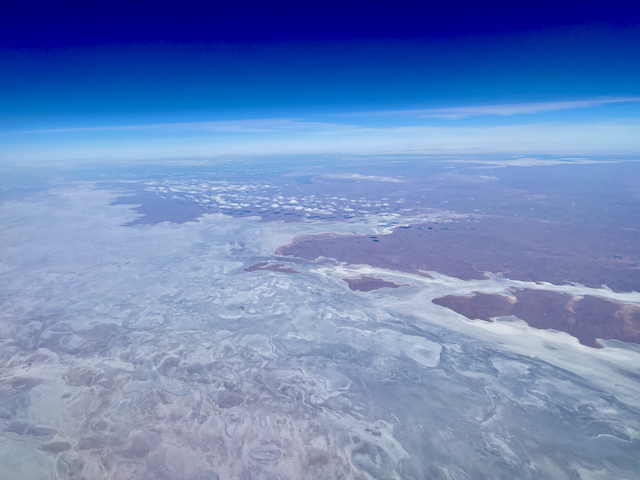
Before we land the pilot takes us on an aerial tour of Uluru and Kata Tjuta. We get our first sense of the magnitude of these two prehistoric natural monoliths. The 15 kilometre foot print of Kata Tjuta almost dwarfs the wedge shaped Uluru which spans a mere five kilometres.
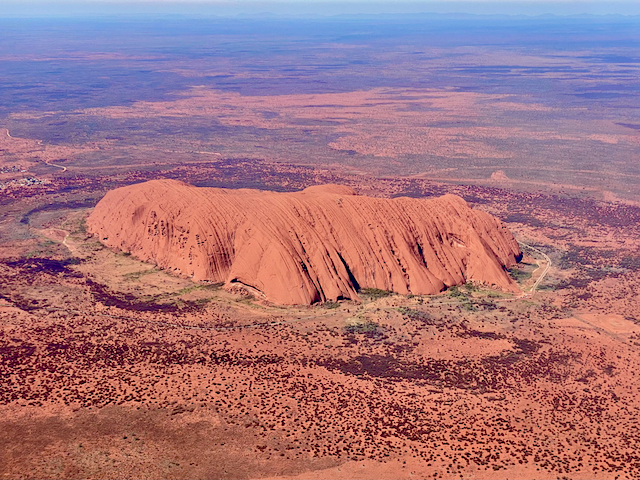
Uluru from the air 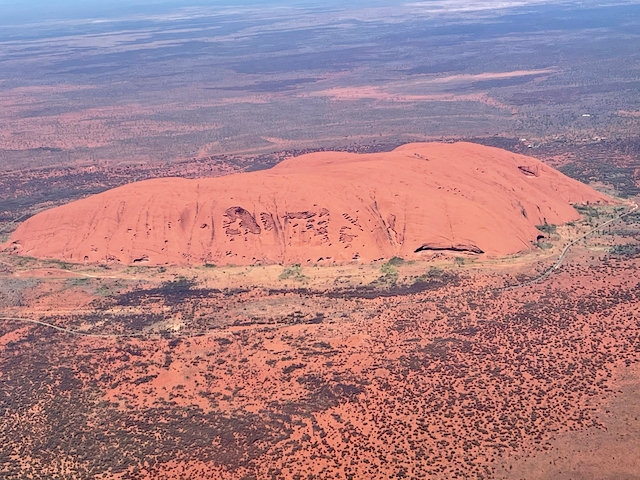
Uluru from the air 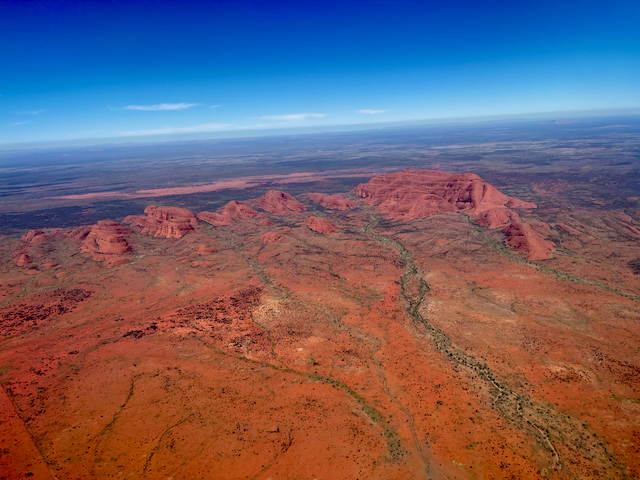
Kata Tjuta from the air 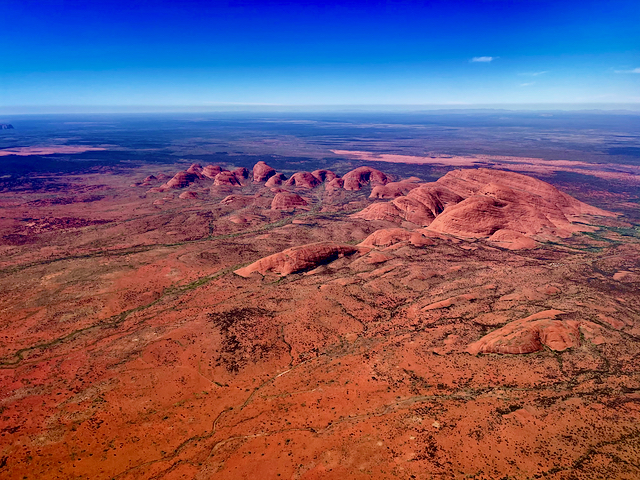
Kata Tjuta from the air 
Kata Tjuta from the air 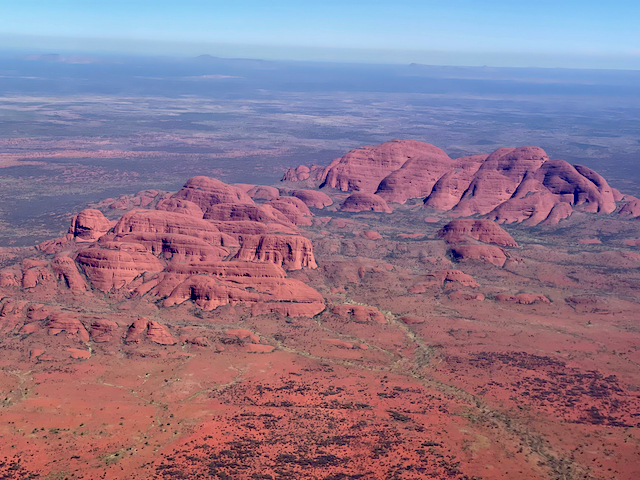
Kata Tjuta from the air 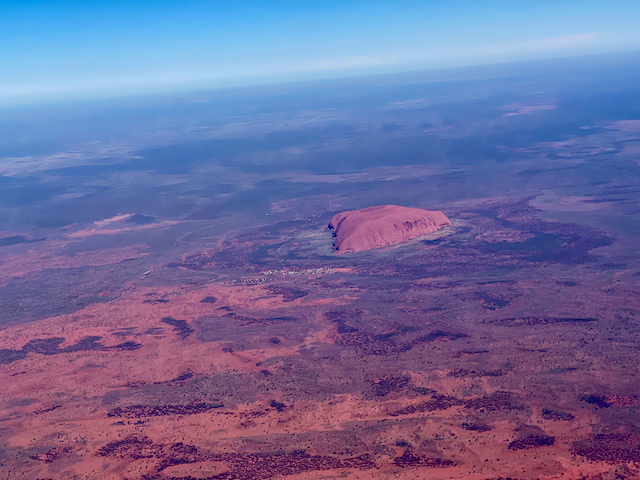
Uluru from the air
We ultimately touch down at Yulara airport and are screened by officials before boarding our coach to the resort. People are in a buoyant mood, excited by the chance for some travel and to see some of Australia’s most well-known natural attractions.
We board the coach, front row seats for us. We pre-notified the tour company of my eyesight. Sitting here is easier than trying to navigate the small tight and dark recesses of the back of the coach!
David, Kerrie, Michael and Kathryn grab seats just behind us as the bus fills for the short trip to the resort.
As we pull away, I am amazed at the landscape. Sure, the soil is red, but there is also a lot of vegetation. Sparse and harsh looking, like the landscape, but thriving in parts. The one thing that is obvious is a massive rock so close you think you could touch it, but given its size, five kilometres in length, it is still kilometres away from us.
The landscape is largely dominated by Spinifex Grass, with a smattering of eucalypt AMD acacia trees here and there. Limited rain fall support the grass and acacia trees. The landscape is red and green, soil and vegetation living in harmony in an environment that is one of the harshest in the world. Three hundred millilitres of rain a year, we got that in three days in Canberra a month ago. Hot days, freezing nights and winds that have eroded the nearby landscape into its present form over millions of years.
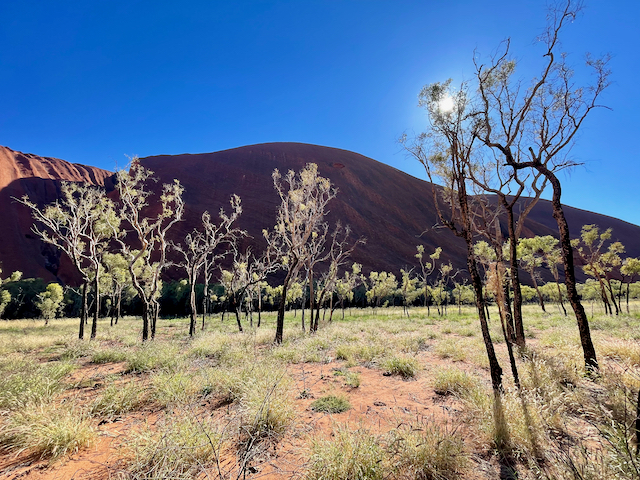
We arrive at the resort, having passed through the only stop sign in town. During peak season and pre COVID a population of 1500 workers support the local tourism trade, now 500 jobs are all that is on offer. A tough time for locals and fly in fly out workers. There is no local economy, no business as such, this is a place almost entirely reliant on tourism dollars. So tours like ours have become the lifeblood.
Our tour hosts Cos and Adrian give us a run down of the three days as we arrive at the resort, we alight the bus and enjoy lunch as we wait for room allocation. The six of us sit and enjoy a buffet lunch and work out what other activities we are keen on doing.
We have a number already planned, including an outdoor dining experience, tonight, a tour of the base of Uluru, tomorrow afternoon, and a Field of Lights tour, tomorrow night. We’ve got plenty of time to book additional tours. We discuss our options and settle on a sunrise tour of Kata Tjuta tomorrow morning to start with.
After lunch we get allocated our room and settle in. We were the last to get rooms, which was a little annoying, but we are on holiday so simply sit and enjoy our surrounds. After settling in to our rooms, we walk to the town centre for some supplies and to explore the local tourist shops, all three of them!
We then wander to a local look out for our first glimpse at Uluru. I first go with David and Kerrie as Mardi, Kathryn and Michael continue shopping. Then I go again with Mardi, Michael and Kathryn. Everything is close and both trips to the lookout take around 15 minutes in total.
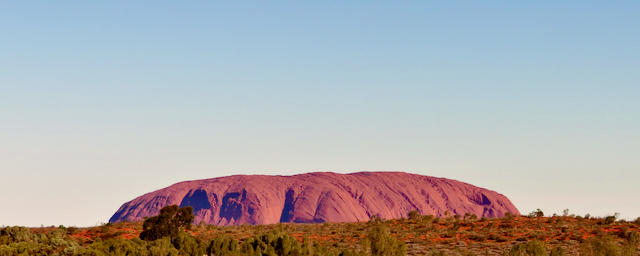
We then get ready for our first experience, dining under the stars. It is starting to cool down as 5.30pm as the sun sinks in the west, but still pleasant, still and a perfectly clear sky.
We enjoy Canapes and Champagne as we watch the sunset, with Uluru in one direction and Kate Tjuta in the other. As darkness falls, we take our seats at superbly laid out tables. The red sand under our feet and seats is soft under foot. We all sink into the sand as we sit. We sit quietly as Dwayne kicks off the night’s entertainment with haunting didgeridoo in front of a campfire, a large eucalypt hangs motionless in the air above him as his rhythmic playing delights the crowd. We are taken back in time, I sit and think about the custodians of this great land, how they made it their own, how they survived in conditions bordering on impossible. But they found a way. A way to live, survive, thrive and create a rich tapestry of history we still know too little about.
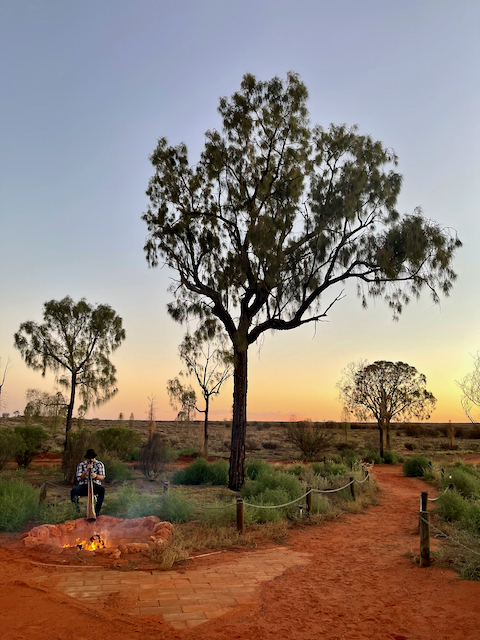
Digeridoo playing under a eucalypt 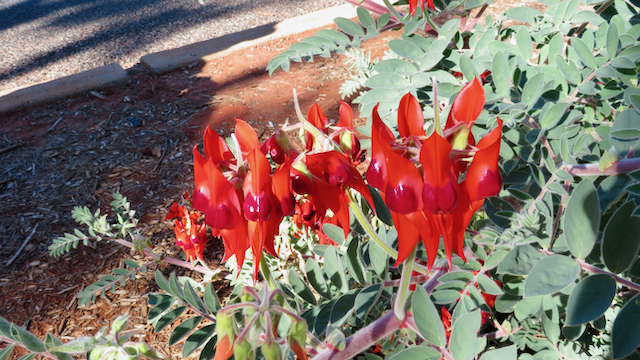
Sturt’s desert pea 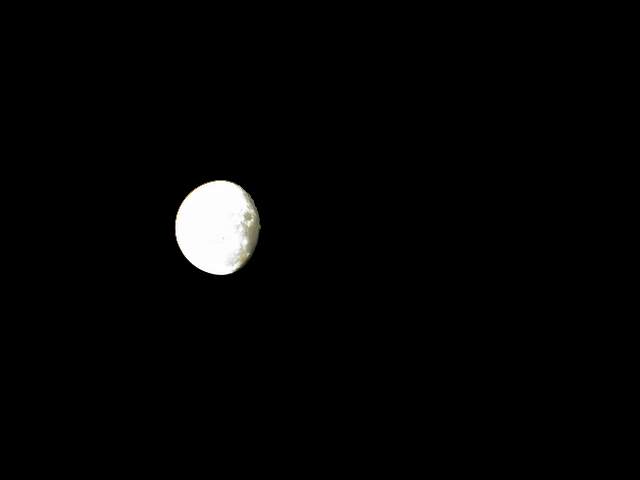
Moon with craters
As the digeridoo continues we are invited to enjoy dinner. Our first course is a tomato soup, delicious. Adorned with native herbs and spices it is the perfect start to a sumptuous meal. Mains includes lamb, barramundi, kangaroo and assorted salads and vegetables. A meal rich in local produce and cooked to perfection. Desert is a selection of typically Australian fare, lemon, chocolate, strawberry are all showcased in delectable little sweet bites.
After dinner we are immersed into the darkness as table lights are dimmed and the star man appears with his laser pointer. For the next forty minutes we are thrown into outer space as we explore the sky above. Much like Carl Sagan took us on a journey on the ship of our mind, our star man tonight takes us on a journey back in time and he explores, explains and excites us with a combination of fable and science. We are enthralled the whole time and after his talk engage with him at our table about meteor showers and galactic distances.
It seems shortly thereafter our buses arrive as the darkness is broken with their bright headlights for the short journey back to the resort.
The next day we are up early, 4.30am! We’ve booked a sunrise tour to Kata Tjuta, followed by a hike through the impressive conglomerate rock structures after dawn. It is the start of a busy day! We arrive at the lookout pre-dawn, Uluru imposing on the horizon to our east and Kata Tjuta to our north. David and I set up camp for some dawn and sunrise shots, Mardi, Kerrie, Michael and Kathryn find a spot with a good view.
For the next hour we stand and watch as the landscape changes colour by the minute. Uluru, first silhouetted, then ablaze as the sun peaks up over the horizon, then again the massive 386 metres high 5 kilometre long wedge shaped monolith comes to life as the sun creates shadow crevices across its billion year old surface.

Uluru at dawn 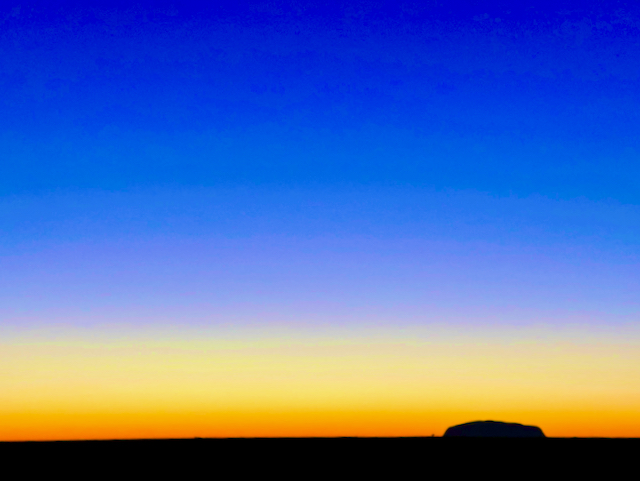
Uluru at dawn 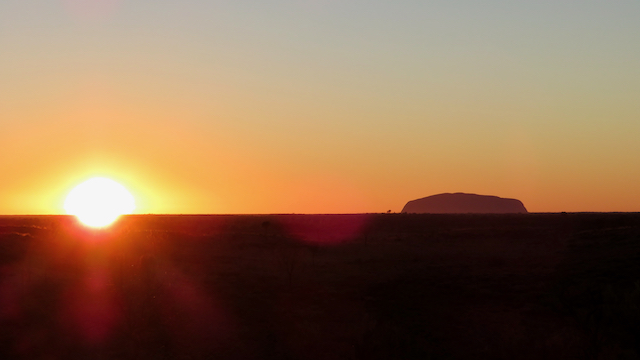
Uluru at dawn 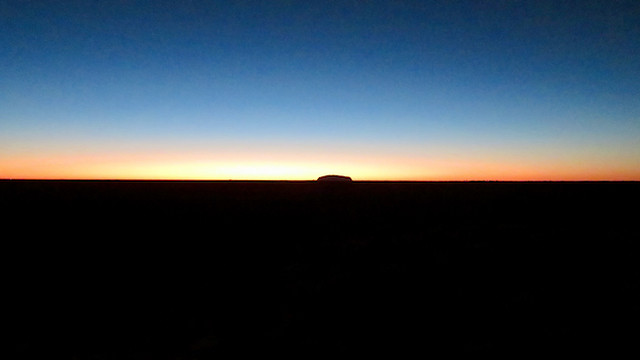
Uluru at dawn 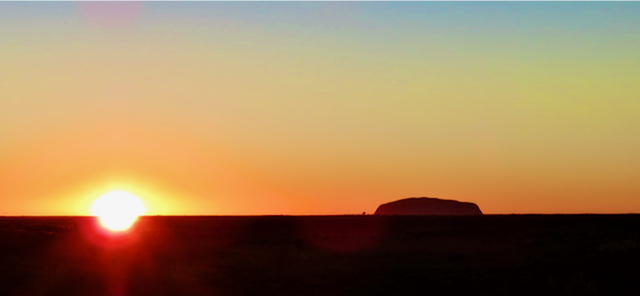
Uluru at dawn 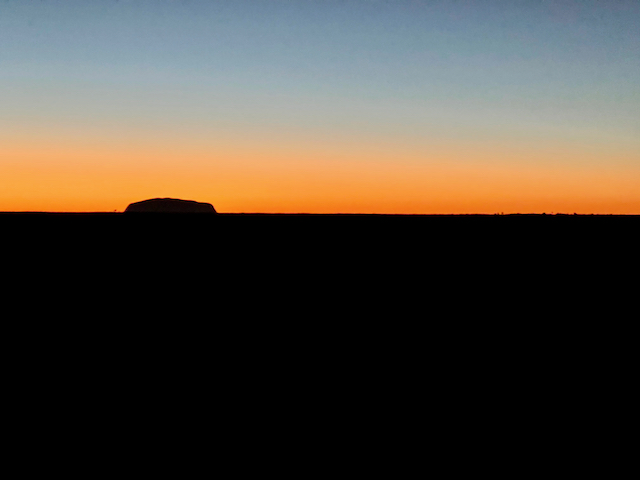
Uluru at dawn
Kata Tjuta is as impressive as it emerges from the darkness and the sun dances off the high points, while the dark ravines remain ghostly murky.
As the sun brings with it full daylight we leave for a quick bus ride to the base of Kata Tjuta to embark on an one hour five kilometre trek into the ravine between two massive of the massive heads. Kata Tjuta literally translated means many heads.
The 36 domes that make up Kata Tjuta cover an area of 21.68 km2 (8.37 sq mi), are composed of conglomerate, a sedimentary rock consisting of cobbles and boulders of varying rock types including granite and basalt, cemented by a matrix of sandstone. The highest dome, Mount Olga, is 1,066 m (3,497 ft) above sea level, or approximately 546 m (1,791 ft) above the surrounding plain (198 m (650 ft) higher than Uluru).
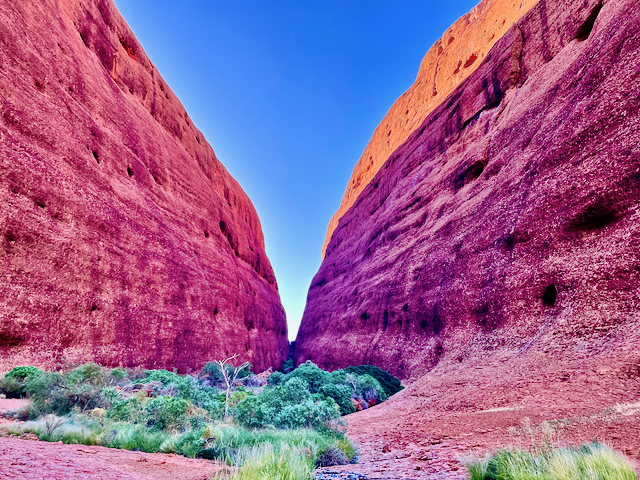
Kata Tjuta 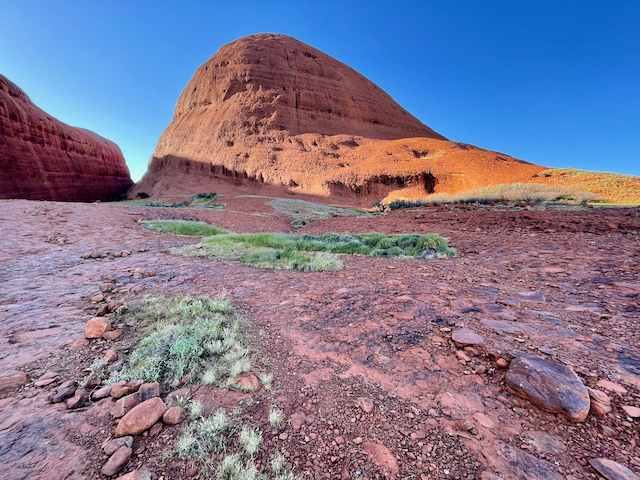
Kata Tjuta 
Kata Tjuta 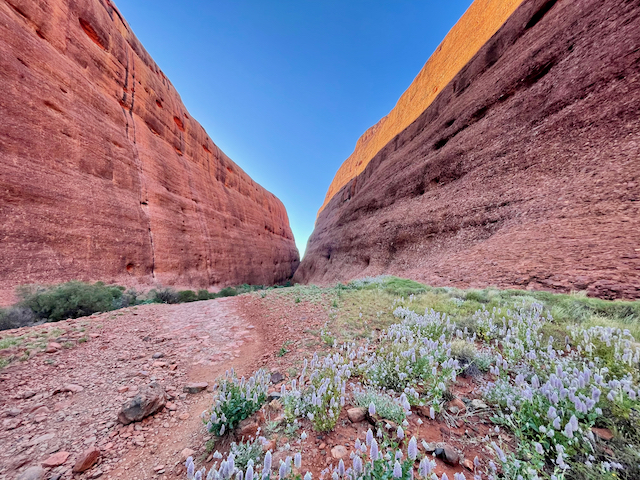
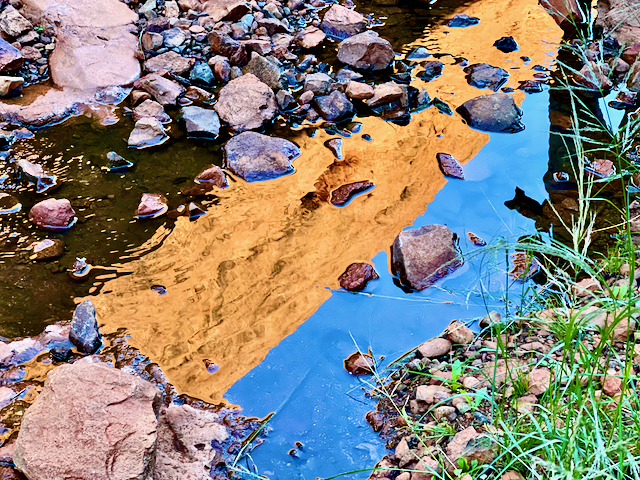
Kata Tjuta 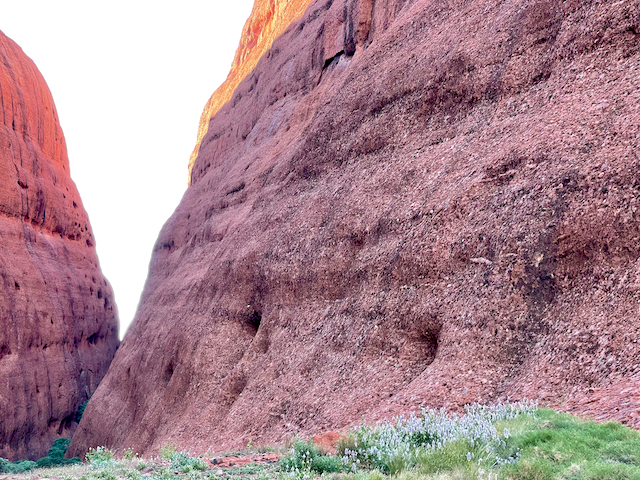
Kata Tjuta 
Selfie 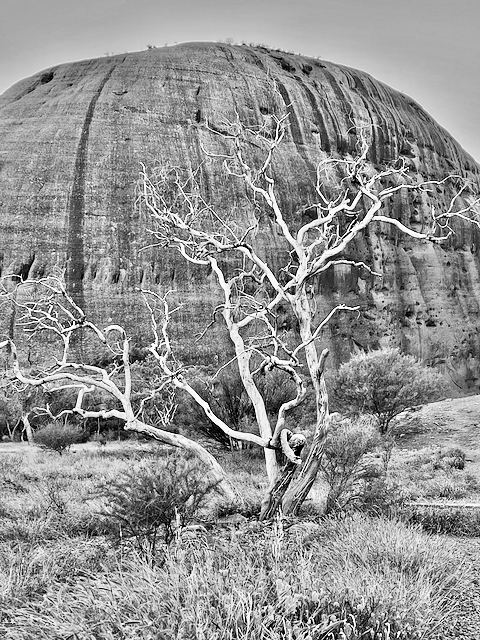
Black and White Tree 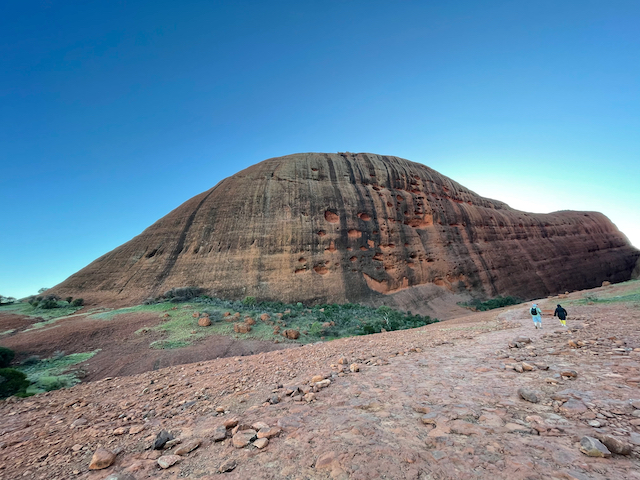
Kata Tjuta
As the bus pulls up, David Kerrie, Mardi and I get off, Kathryn and Michael remain on the bus as they are keen to explore a longer walk, three hours for them!
We commence our walk between two of the heads, they are imposing, standing sentry like protecting the ravine and its riches further ahead. Riches of native flora and lagoons of precious water trapped in the bowels between the two heads. The path, if you could call it that is rough, rugged, uneven, sharp, loose, wending and in parts not really there at all. The four of us struggle along, a tour group of millennials glide past us as if they are walking on plush carpet in bare feet.
We cross man-made bridges, designed to both protect the delicate surrounds, but also so as to not interrupt natural water courses and flora pathways. We eventually reach the platform where the two heads converge and further progress is stopped. We stop and take in the surrounds. Millions of years have passed and these rocks have stood stoically, like a beacon at the centre of this wonderful country. Revered by the first Australians, studied and pawed over by European settlement, the rocks have seen it all and oh what a story they could tell. They were here when dinosaurs walked where we walk now. Where our first Australians ancestors huddled from predators and weather, lived and thrived in the dark recesses and rich flora and water holes. What a place.
The walls of the monolithic heads rise up on either side of us, pock holed where large sections have worn off or simply fallen out as part of the conglomerate mixture. Corresponding boulders sit on the ground beneath many of the pock holes. When did they fall, why did they fall, who witnessed the changing geography are all questions that run through my head as I take in the silence around me.
After taking in the moment, we venture back. The path as uneasy on the return trip.
We reach the end, almost being spat out between the two heads as the path runs downhill to our meeting point with the bus and our return journey to the resort. David and I linger and take some final photos before joining the others on the bus trip home.
When we get back to the resort we enjoy a lazy breakfast and rest by the pool and wait for Michael and Kathryn’s return. The six of then take it easy for a couple of hours before our next event, a trip to Uluru and a walk in some caves and a water hole.
We join our tour group and are drive to the western side of Uluru, our guide, a man in his seventies looks as if this has been his life. He knows a lot and speaks today as he would have to tourists back in the 1980s, time for him has stopped and his world hasn’t moved on as much as the city folk he is now talking to. Despite his arcane language, we learn a lot and are given a first-hand tour of part of the rock, some ancient caves, including rock paintings from eons ago as well as a watering hole deep within a crevice. I stand and take it all in, listening to the wind in the tress above us, spinning stories and ghosts of long ago, it is quite eerie and awe inspiring at the same time. The climate is so harsh, yet people lived here and made lives here, family units enjoyed each other’s company, they cared for their elders, educated their young and grew up generation after generation in a climate where most of those in the tour today would perish. This is a special place.
The tour guide offers an opportunity to touch the rock, most people gleefully paw and sit on parts of the rock, I don’t. My little way of showing respect to a place, a people, so poorly treated and maligned by European influence. I can’t change what has gone before me and I have little influence over our future, suffice to say personally being respectful and thoughtful is the least anyone can, should, do.
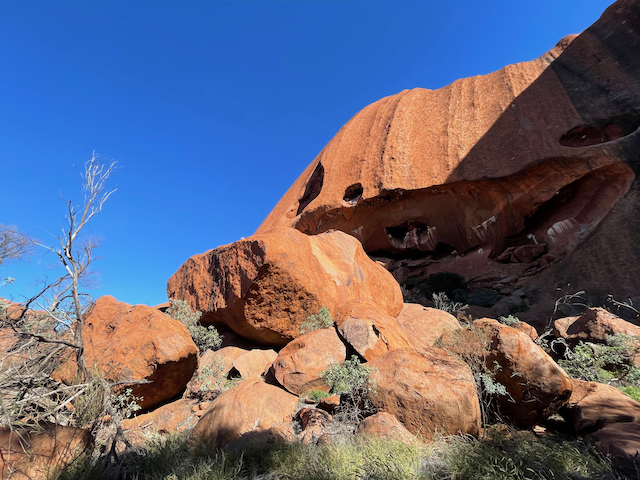
Uluru 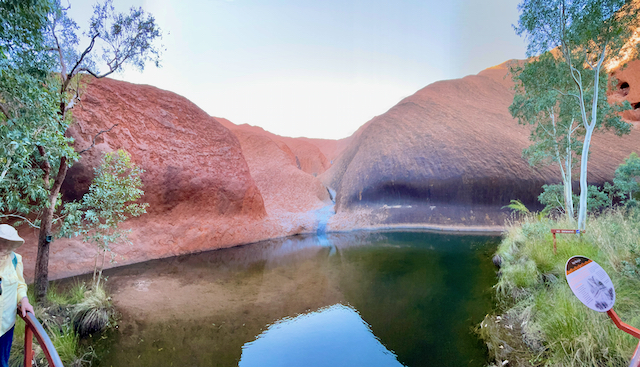
Uluru water hole 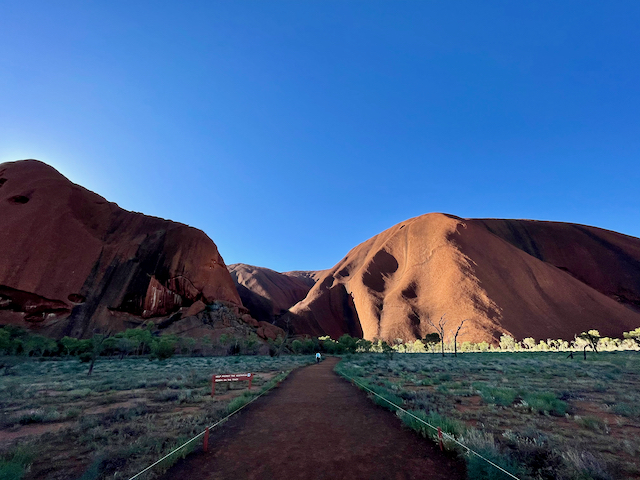
Qalking to Uluru
We depart as the sun is setting and head back to the resort. Our next event is walk through the field of light. Quite literally it is a field of light! We have a couple of hours, so we settle into the bar and order a few drinks and some snacks for dinner. The resort is still recovering from COVID, so staff and supplies are limited, but we still enjoy some great snacks and drinks before we head out.
During dinner we plan our activities for tomorrow. We have a free morning before we head home. So we opt for a bike ride around Uluru (Me, Kathryn and Michael), a walk around Uluru (David and Kerrie ) and some traditional animal painting (Mardi).
We head off to our tour, a short bus ride to an open filed, which is literally covered in LED lights.
We walk around the colourful display of some 50,000 globes that change colours. The pathway is around 700 metres. There are few vantage points to get high and enjoy a more panoramic experience, but nonetheless it is an enjoyable experience.
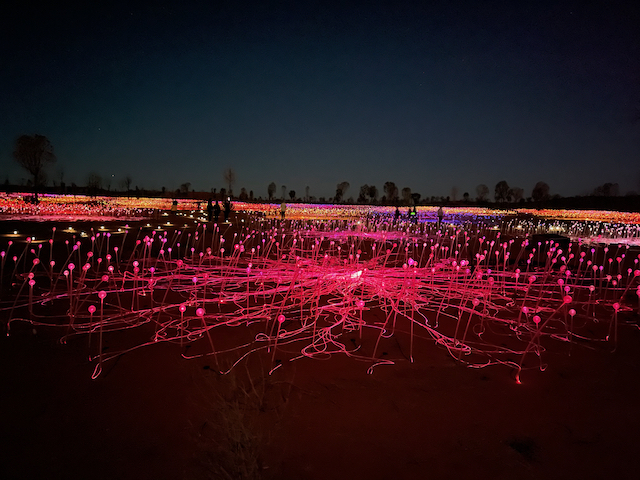
I play with some long and short exposures to try and capture the lights, David and I search for better vantage points and after an hour or so we head back to our bus.
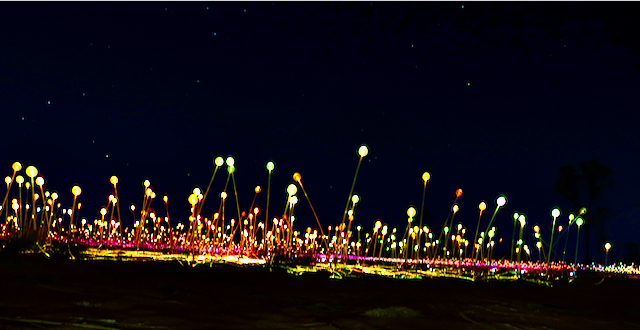
Field of lights 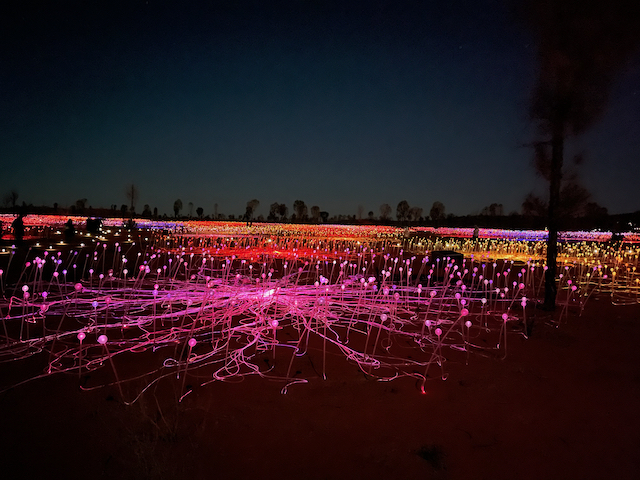
Field of lights 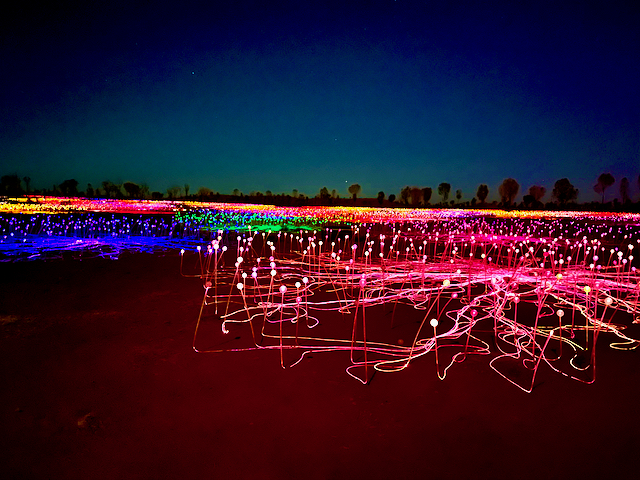
Field of lights 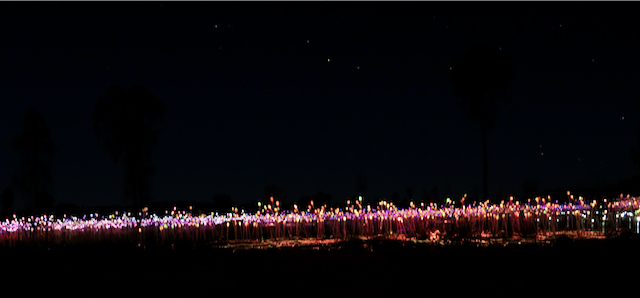
Field of lights
We head back to the resort and call it a night.
The next day we all meet for breakfast before heading off to our final expedition. Mardi stays at the resort for her painting class and the five of us head off to the cultural centre. Kathryn, Michael and I are hoping to hire a bike.

As we arrive at the cultural centre, we get off and leave David and Kerrie. They have opted to walk, whereas we will ride the last two kilometres to the rock. If we get a bike!
As we approach the bike hire man, he asks us to wait as he serves people who have pre booked. We stand and look at the bikes and chat, waiting for our turn. We eventually book and are on our way. The bike man, while a little gruff, is nice and chatty, and has had a tough time of it during COVID. He’s pleased to be back in business.
Check the experience our here: https://www.outbackcycling.com/uluru-bike-ride?gclid=Cj0KCQjw1a6EBhC0ARIsAOiTkrGaEnf4loTcSintfjqWdvc03g1iCnNTYAL3mNBjI4SiXRaGgFoXUqgaAmkoEALw_wcB
We secure our bikes, check the brakes and gears and Kathryn leads the way, with Michael following, me in the middle. We ride the two kilometres to the start of the official track around the rock and turn right at the Mala Carpark for our anti-clockwise loop. The sun on our back we head off. Our ride starts at the old climbing spot, now discontinued following banning walking on the rock. We travel down the western edge of the wedge, the shortest edge. We turn left as we continue along the southern wedge, the longest part passing the Mutitjulu watering hole. We are mostly in shade as the wind howls around the back of the rock. We see a wave like section of rock, carved out by the wind over millions of years. Kathryn is fantastic as a guide, calling out to me to veer right and left to avoid over hanging trees and jutting rock. We stop periodically to take photos and immerse ourselves in the awe inspiring structure. As we reach the south eastern pint we stop for a drink. We are about halfway around. We turn left again and are taken a little bit away from the rock as we pass a spiritual and sacred area (Kuniya Piti). We ride respectfully and silently as we pass this area. Once past we are around 500 metres from the rock as we pass along its north-east face. The sun on our backs again, we can see various markings in the rocks face, one colloquially called the brain. These ancient natural markings look a lot like a human skull and brain from the side. As we venture towards the end of the north east face as the path turns north west we stop and venture into some caves and a gorge (Kantju Gorge, Kjukatjapi Warayuki and Mala Puta). We read the markings and walk to an ancient watering hole deep within the gorge. The rock towers some three hundred metres above us. We explore the caves and learn about how life was lived thousands of years ago. After our stop off, we get back on our bikes and complete the loop It has taken us around 90 minutes and has been a thoroughly enjoyable experience.
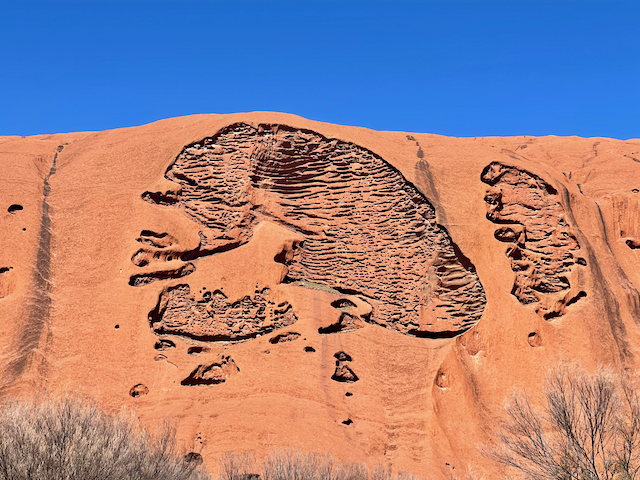
The brain 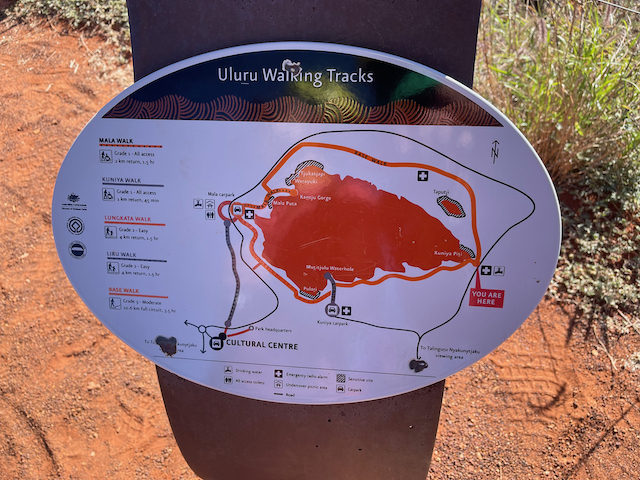
The ride 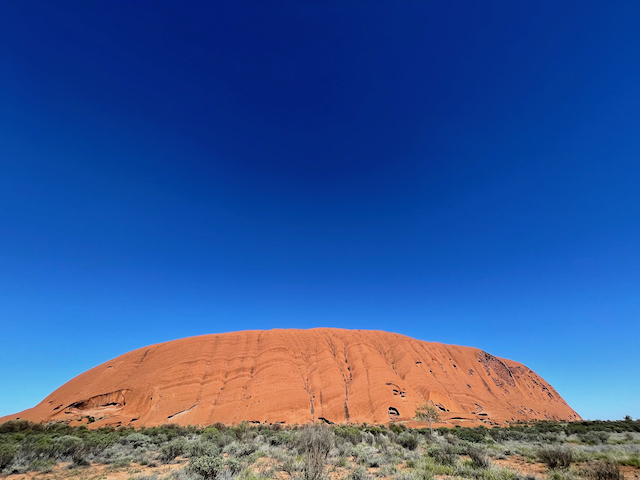
Uluru, north 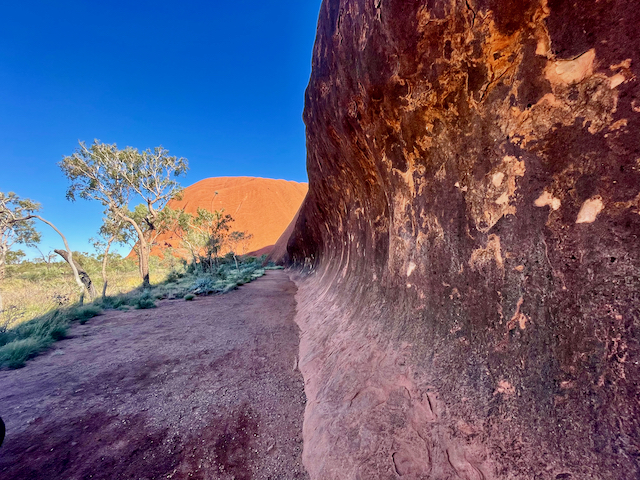
Uluru, south 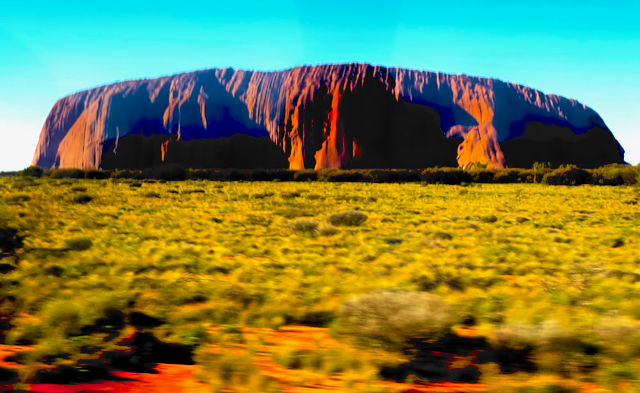
Uluru, west 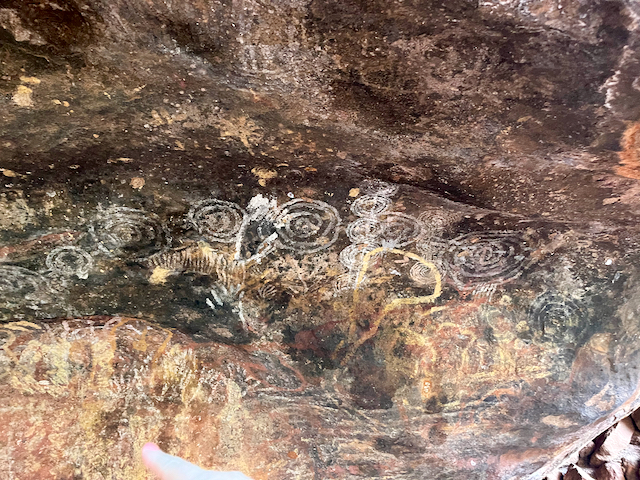
Cave art 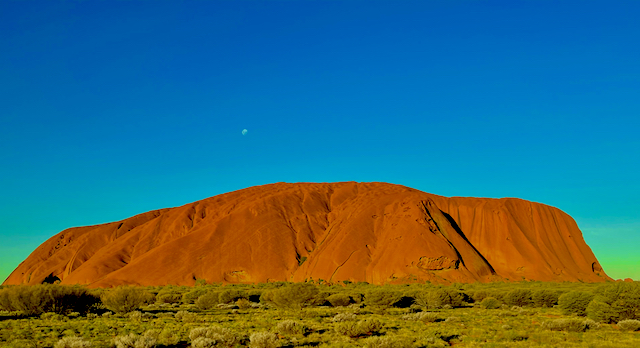
Uluru, east 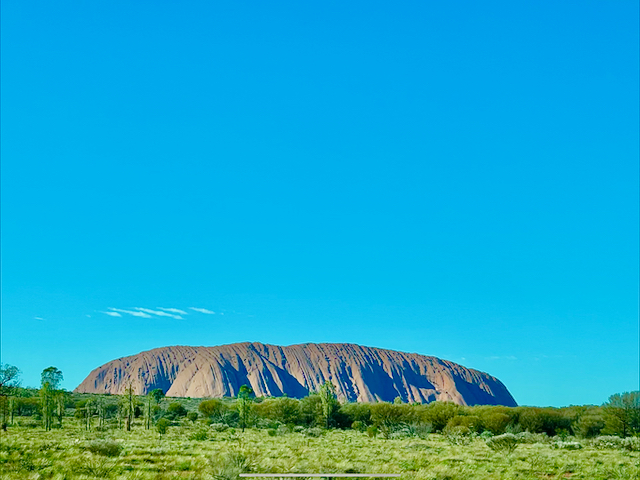
Uluru, west
We head back to the cultural centre, drop our bikes off and locate David and Kerrie. We wander through the gift shop and cultural centre as we wait for our bus.
Our bus arrives and before we know we are back at the resort and sit down to lunch, the six of us back together. We are entertained at lunch by Dwayne, the local digeridoo player, he also entertained us at our dinner on night one. Lunch is enjoyable and gives us a chance to catch our breaths after 48 hours of almost non-stop sightseeing.
After lunch it is time to locate our bags and head on back to the airport. We’ve been here for a little over 48 hours and haven’t really stopped but we are leaving knowing we’ve spent our time well and seen just about everything we could have seen. It is truly a magical space. As city lovers, having been to New York nine times, central Australia wasn’t something on our radars 12 months ago. But with travel restrictions and a sense of adventure we took the plunge and visited a place that is quite literally a world away from New York.
Whereas New York and Uluru share the bedrock of millennia past, today they are at the extremes of human existence. As much as I love the hustle and bustle of New York, I also loved the sense of tranquillity of the waterhole at Uluru. The two places are so different, but equally so easy to fall in love with. The one thing that binds them is the sense of adventure. Dropping down into a subway and hopping on a train to a new place is as much fun as descending into a cave and listening to the spirits of an era most have forgotten.
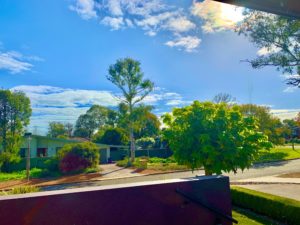
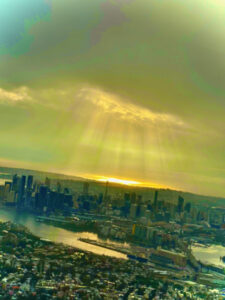
3 thoughts on “April 2021: Uluru and Kata Tjuta”